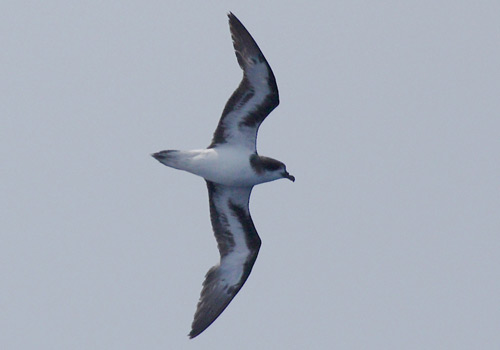Alternative name: Cahow
- Pterodroma cahow
Identification
Length 38cm. Wingspan 89cm. Large, long-winged gadfly-petrel similar to Black-capped Petrel but much smaller. Greyish-brown above darkening to blackish on rump, pale band over base of blackish tail. Upperwing blackish-grey, underwing white with blackish tip and margins and some show short diagonal bar across coverts. Crown and hindneck blackish-grey, throat and underparts white. Iris dark brown, bill black, legs fleshy-white.
Adult and juvenile alike.
Similar Species
Closely resembles Black-capped Petrel but distinguished by lack of white hindneck and reduced white band over tail. However, some atypical darker examples of Black-capped are very similar in plumage and best separated by large size and stouter bill. Differs from Fea's Petrel, Zino's Petrel and Soft-plumaged Petrel in the darker upperparts and the white band on the underside of the wing, but shares with them the typical Pterodroma flight pattern.
Distribution
A western Atlantic species with breeding confined to small islets off Bermuda but at sea dispersing extensively across the temperate North Atlantic. Considered extinct for centuries until rediscovery in the 1930s, with breeding site discovered in 1951, and population still very low, 75 pairs in 2006, but increasing to 105 pairs by 2013. A conservation program has provided artificial nest burrows and is trying to transplant some young to Nonsuch Island from the tiny, hurricane-threatened islets where it has been nesting. The first egg laid on Nonsuch Island hatched and a young fledged in 2009.
Highly pelagic and mobile away from the breeding site, with geotagged birds being logged going on feeding flights of 2,400-6,400 km merely to get a fish supper for their chicks in the nests, and non-breeding birds moving as far as European waters[1], an astounding feat which also requires incredible levels of navigational accuracy. Long suspected and recently confirmed in United States waters, and now also confirmed in Canadian waters off Nova Scotia and Newfoundland, and also a sighting less than 300 km from the west coast of Ireland. Has been recorded in very small numbers on pelagic trips off North Carolina in summer. One captured and ringed on an islet in the Azores in November 2002 and the same bird recorded in November 2003.
Taxonomy
This is a monotypic species[2].
Treated as conspecific with Black-capped Petrel P. hasitata by some authors.
Habitat
Breeds on rocky islets, otherwise pelagic, rarely follows ships. Present on breeding grounds from October/November until May but nocturnal on land.
Behaviour
Flight
Little-known, but fast and powerful with high sweeping arcs as in other Pterodroma species; able to fly 800 km per day. Rarely follows ships.
Breeding
Single white egg weighing about a third of the wight of the female bird is laid in early January in burrow or rocky crevice. Due to the large size of the egg, the female is not able to repeat the laying if the egg is lost to, for example, rat predation. Incubated by both sexes for 51-54 days, young fledged in 90-100 days. A parent on a feeding trip may be away from the nest for up to 4-8 days before returning with food for the young.
Managed nest-holes have baffle devices to prevent entry of tropicbirds.
Diet
Surface-dwelling crustaceans, squid and fish.
References
- Bermuda Audubon Society Newsletter 20 (2): 2
- Clements, J. F., T. S. Schulenberg, M. J. Iliff, B.L. Sullivan, C. L. Wood, and D. Roberson. 2013. The eBird/Clements checklist of birds of the world: Version 6.8., with updates to August 2013. Downloaded from http://www.birds.cornell.edu/clementschecklist/download/
Recommended Citation
- BirdForum Opus contributors. (2024) Bermuda Petrel. In: BirdForum, the forum for wild birds and birding. Retrieved 9 November 2024 from https://www.birdforum.net/opus/Bermuda_Petrel
External Links
The Bermuda Petrel was the bird of the month of the Society for Conservation and study of Caribbean Birds recently; this is a relatively complete presentation of the species.




